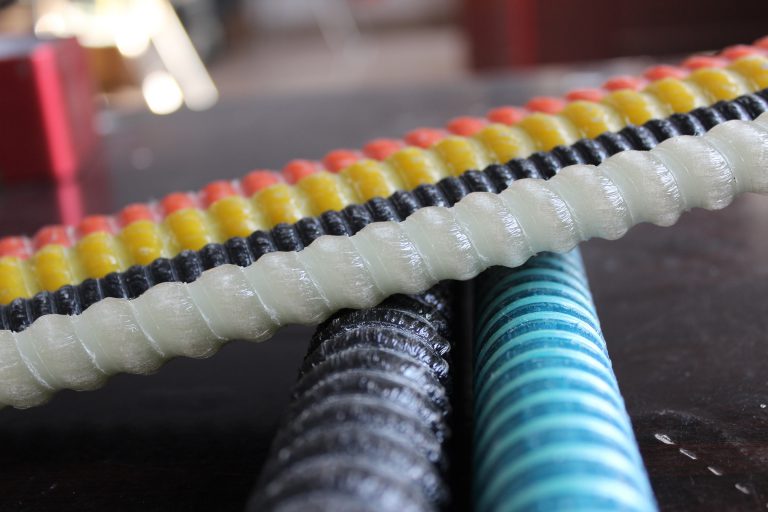For Conrete Reinforcement
FRP (Fiberglass Reinforced Polymer) is a composite material made of a polymer matrix reinforced with fibers. The fibers are usually glass (in fiberglass), basalt, carbon, or aramid. The polymer is usually an epoxy, vinyl ester, or polyester thermosetting plastic.
FRP bar has been developed as a non-corrosive alternative to steel for concrete reinforcement. FRP bar is suitable for any structural or architectural application where a material that is corrosion resistant, lightweight, or non-conductive is required.
FRP bar is the ideal solution for concrete reinforced projects, such as bridges, barrier walls, decks, diaphragm walls (soft eye), tunnel segments, garages, pavements, Wharfs, sea walls, wave breakers retaining walls and fence systems.
Download Product Sheet

| Comparison Snapshot | BFRP | Steel | GFRP | Stainless Steel |
| Strength | +2.5X | Traditional | +2.0X | Traditional |
| Weight | 1/4X | Heavy | 1/4X | Heavy |
| Carbon Footprint | Low | Bad | Low | Bad |
| Conductivity | No | Yes | No | Yes |
| Saltwater Deterioration | No | 1 Day | No | 2-5 years |
| Easy to Transport | Bar or Coil | Heavy, Long & Bends | Bar or Coil | Heavy, Long & Bends |
GFRP Rebar Properties
| Designation of bars | Nominal cross-sectional area | Guaranteed tensile strength | Tensile Modulus of elasticity | Transverse shear strength |
| (CSA S807 Table 1) | (CSA S807 Table 1) | (ASTM D7205) | (ASTM D7205) | (ASTM D7617) |
| Designated Diameter in mm | mm2 | MPa | GPa | kN |
| 6 | 32 | 1105 | 46-70 | 7 |
| 8 | 50 | 1050 | 46-70 | 23 |
| 10 | 71 | 1002 | 46-70 | 31 |
| 13 | 129 | 981 | 46-70 | 54 |
| 15 | 199 | 960 | 46-70 | 79 |
| 20 | 284 | 898 | 46-70 | 109 |
| 22 | 387 | 877 | 46-70 | 156 |
| 25 | 510 | 843 | 46-70 | 188 |
| 30 | 645 | 796 | 46-70 | 202 |
| 32 | 819 | 758 | 46-70 | 220 |
| 35 | 1006 | 722 | 46-70 | 223 |
- Tensile properties were calculated using nominal cross-sectional areas.
- The designers should contact the bar manufacturer for the latest updates of this technical data sheet
Sustainability Comparison Table
| SFT-Bar® | Steel | |
| Production | 43% less CO2 Emissions | High CO2 Emissions |
| Transport | Fewer construction freight | High construction freight |
| Service Life | Long (resistance to corrosion) | Short due to corrosion |
Comparison table
| Cost and Performance comparison | SFT-GFRP rebar | Black steel rebar | Epoxy coated rebar (ECR) | Galvanized steel rebar | Stainless steel rebar |
| Cost comparison | |||||
| Life Cycle Advantage | Longer +++++ | Short | Longer+ | Longer++ | Longer++ |
| Initial cost of material | Grade I – comparable to black steel rebar Grade II – Comparable to Epoxy coated rebar | None | High | High | Higher ++ |
| Transport savings | Yes | No | No | No | No |
| Concrete cover savings | Possible | No | Possible | Possible | Possible |
| Labor & Injury Savings during installation | Yes | No | No | No | No |
| Corrosion Resistance | |||||
| Corrosion risk profile | No | Very High | Yes | Possible | Low |
| Contact corrosion/ Corrosion at bends | No | Yes | Susceptible | Susceptible | Susceptible |
| Cathodic protection needed | No | Yes | Limited to coating | Susceptible | Susceptible |
| Acid rain, Acid soils, marshes | No | Yes | Limited to coating | Susceptible | Susceptible |
| Rust Expansion/Rust staining | No | Yes | Limited to coating | Susceptible | Susceptible |
| Alkali in concrete | No | Yes | Limited to coating | Susceptible | Susceptible |
| Chloride, Sulphide stress corrosion | No | Yes | Limited to coating | Susceptible | Susceptible |
| Mechanical Advantages | |||||
| Thermal Insulator | Yes | Poor | Poor | Poor | Poor |
| Electrical Insulator/ Non-Magnetic | Yes | Poor | Poor | Poor | Poor |
| Weight | 1/4 | 1 | 1 | 1 | 1 |
| Long term bond concrete | Excellent | Poor | Good | Poor | Good |
| Tensile Properties | Excellent | Okay | Good | Good | Excellent |


